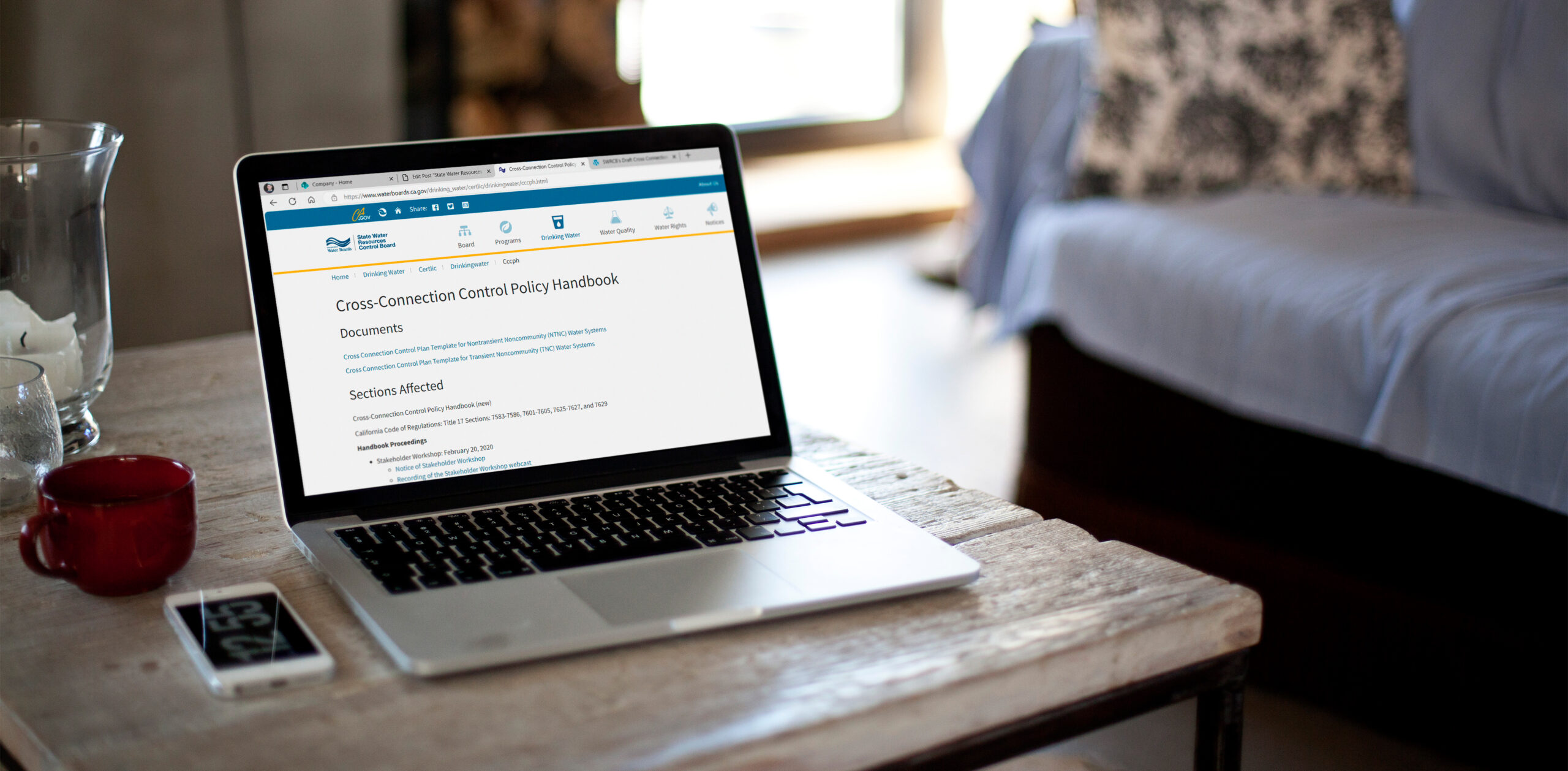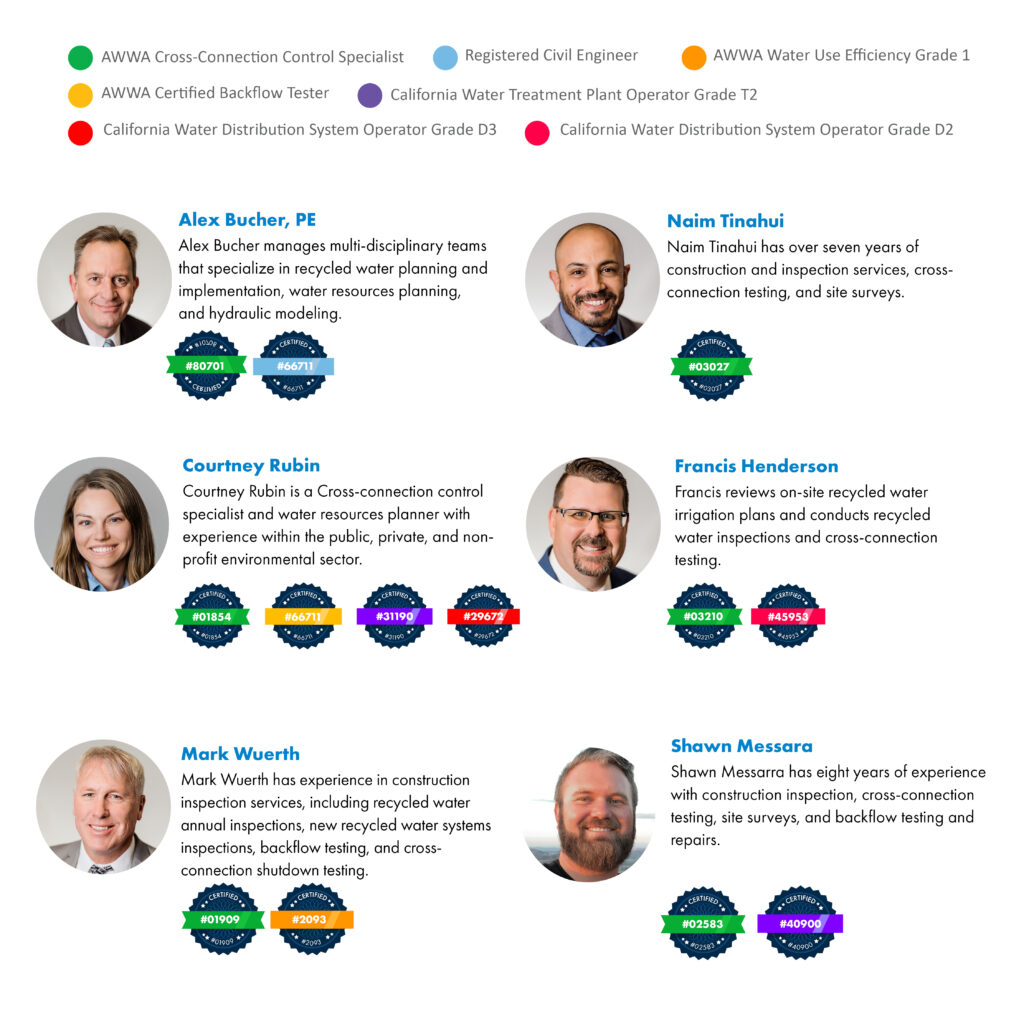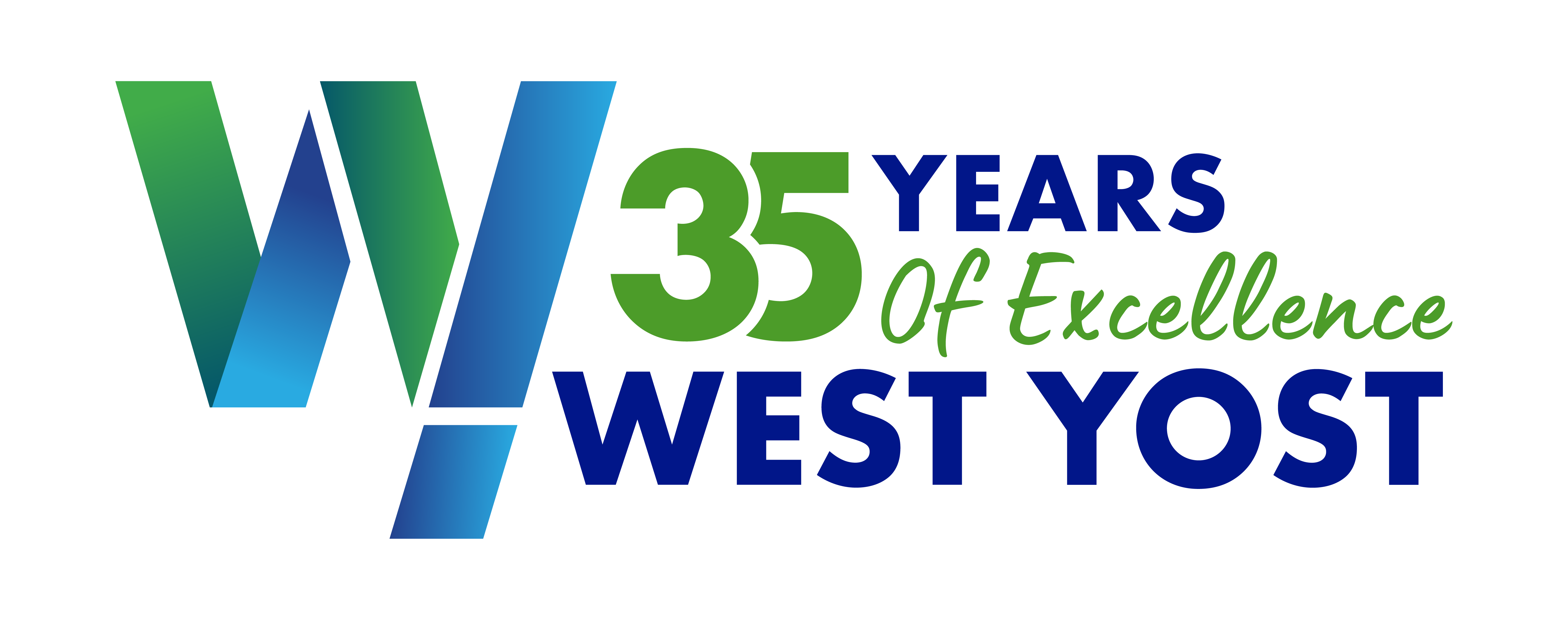State Water Resources Control Board Cross-Connection Control Policy Handbook

By Courtney Rubin, Cross-Connection Control Specialist
This article contains and answers the following:
- Cross-Connection Control Policy Handbook (CCCPH)
- State Water Resources Control Board (SWRCB)
- Public Water Systems (PWS)
- Cross-Connection Control Plan
- Hazard Assessments
- Backflow Prevention Assembly (BPA)
What is the purpose of the Cross-Connection Control Policy Handbook (CCCPH)?
What are the existing, proposed, and new elements?
What is required from Public Water Systems as part of the CCCPH?
How can West Yost support your Cross-Connection Control Program?

The Cross-Connection Control Policy Handbook (CCCPH) is in effect as of July 1, 2024. The CCCPH replaces and expands CCR Title 17 which has remained largely unchanged since its original adoption in the 1980s. The purpose of the CCCPH is to protect public health by establishing standards and practices for public water systems to protect drinking water distribution systems from the backflow of undesirable liquids, gases, and substances. The full text of this regulation is available here
The new State Water Resources Control Board (SWRCB) Cross-Connection Control Policy Handbook (CCCPH) builds upon Title 17 CCR regulations and will include four new elements.
Existing Title 17 Elements
- Operating Rules and Ordinance
- Conducting Surveys
- Backflow Protection
- One person trained in Cross-Connection Control
- Establishment of Testing Procedure
- Maintenance of Records
Proposed CCCPH Elements
- Operating Rules and Ordinance
- Conducting Hazard assessments
- Backflow Protection
- Cross-Connection Control Coordinator
- Identified Backflow Assembly
- Testing Procedures
- Maintenance of Records
- New elements:
- Use of Certified Testers and Specialists
- Backflow Incident Response
- Public Outreach and Education
- Local Entity Coordination
The CCCPH applies to Public Water Systems (PWS) throughout California. A PWS is defined in the California’s Health and Safety Code (HSC, Section 116275 (h)) as a system that provides water for human consumption through pipes or other constructed conveyances that has 15 or more service connections or regularly serves at least 25 individuals daily at least 60 days out of the year.
This definition includes:
- Community Water Systems
- Non-Transient Non-Community Water Systems
- Transient Non-Community Water Systems
The requirements under the CCCPH may be different depending on the size and type of the PWS. Below are the details of what the new CCCPH includes:
1. Cross-Connection Control Plan Submittal (CCCPH Section 3.1.4):
An existing PWS must submit to the State Water Board a Cross-Connection Control Plan (Plan) no later than 12 months after effective date of the CCCPH, which will be July 1, 2025. The Plan must be developed in consultation with a cross-connection control specialist (1,000 or more service connection) and a PWS must have at least one cross-connection control specialist as a permanent or contracted employee (3,000 or more service connections). The Plan must include at a minimum the following:
- A description of how the PWS will achieve and maintain compliance
- A description of the process, personnel, and timeframes for completing hazard assessments
- A description of corrective actions for water users failing to comply with program provisions
- A description of the process and timeframes for ensuring each backflow prevention assembly (BPA) is inspected and tested
- A description of the process and timeframe for ensuring each non-testable backflow preventer for internal protection that is under the PWS ownership or administration is installed and maintained according to the California Plumbing Code
- Contact information for cross-connection control personnel
- A description of the recordkeeping and tracking system for the program
- Required information for user supervisors, if any, pursuant to CCCPH Section 3.2.2.f
- Corrective actions, including timeframes, the PWS will implement when:
- a cross-connection exists and the BPA installed is not commensurate with the premise’s hazard or no BPA is installed, or
- a BPA needs to be replaced or maintained
- A description of the public outreach and education program
- Procedures for coordination with local entities such as building or plumbing officials
2. Initial Hazard Assessments (CCCPH Section 3.2.1):
Each PWS must conduct an initial hazard assessment of user premises within its services area. (Non-community water systems must perform an initial hazard assessment by July 1, 2026). The assessment must determine with an existing BPA, if any, provides adequate protection based on the degree of hazard. Single-family residences are included in the hazard assessment process. Hazard assessments completed prior to the adoption of the CCCPH may be considered with appropriate documentation according to CCCPH section 3.1.4
3. Follow-up Hazard Assessments (CCCPH Section 3.2.1):
A PWS must perform follow-up hazard assessments in coordination with local entities under the following criteria:
- A user premise changes account holder (excluding single family residences)
- A new user premise is connected to the PWS
- Evidence exists of changes in activities or materials on a user’s premise
- Backflow from a user’s premise occurs
- Periodically, as identified in CCCPH plan
- When requested by the State Water Board
- Existing hazard assessment may no longer accurately represents the degree of hazard
4. Swivel-Ell (CCCPH Section 3.2.2.d): A swivel-ell may be used when temporarily substituting tertiary recycled water use areas with potable water from a PWS when specific criteria are met.
5. Fire Sprinklers (CCCPH 3.2.2.e): A PWS must ensure its distribution system is protected with no less than a double check valve backflow prevention assemblies (DCs) protection for a user premise with a fire protection system. Public Water Systems have ten years to bring existing fire protection services into compliance. This requirement includes single-family residential properties with fire suppression sprinkler systems unless specific criteria is met. Details can be found in the CCCPH.
6. Installation Criteria for Backflow Protection (CCCPH 3.3.2): DCs installed or replaced after the adoption of the CCCPH must be installed following the same requirements of a RP. Below ground installation can be considered by the PWS where no alternative options are available.
7. Backflow Incident Notification (CCCPH Section 3.5.3): Each PWS must notify the State Water Board of any known incident of backflow within 24 hours of the determination.
West Yost has a team of AWWA certified Cross-Connection Control Specialists from Northern California to Southern California with experience drafting Cross-Connection Control Plans and administering cross-connection control programs. West Yost has been tracking the Policy Handbook and working with State Board authors to understand the intent of each item contained within the CCCPH. West Yost can help you create a pathway towards full compliance and prepare a plan that will be approved by the State Water Board.
Below is a List of Services West Yost can provide:
Cross-Connection Control Plan: Prepare Cross-Connection Control Plans in accordance with the Cross-Connection Control Policy Handbook.
Hazard Assessments: Perform initial or follow up site hazard assessments; determine the degree of hazard at sites; confirm appropriate backflow prevention assembly present for hazard.
Cross-Connection Control Program Support: Program management and support in backflow testing notifications and tracking.
Standards and Details Development: Draft of Standard Specifications, Details, and Drawings related to backflow prevention assemblies.
Ordinance Assistance: Update or create ordinance language to establish authority to enforce the Cross-Connection Control Policy Handbook.
Plan Review Review of proposed construction plans, plumbing plans, irrigations plans for compliance with Agencies’ Specifications and Standards Drawings and Cross-Connection Control Policy Handbook Compliance.
User Supervisor Program: Develop program requirements, materials, and conductUser Supervisor Training in-person or by videoconferencing. Ability to conduct the training in English or Spanish.
Cross-Connection Shutdown Tests: Perform visual or a pressure differential initial (new construction) cross-connection control shutdown tests and follow-up cross-connection shutdown tests on potable and recycled water systems.
Our Team
AWWA Certified Cross-Connection Control Specialist Team
West Yost’s inspectors are American Water Works Association (AWWA) certified Cross-Connection Control Specialist and have successfully inspected over 5,000 irrigation systems and conducted over 2,000 pressure differential cross-connection shutdown tests for sites such as hospitals, schools, golf courses, homeowners association, commercial and industrial centers , and parks.

By Courtney Rubin, Cross-Connection Control Specialist #01854
Courtney Rubin is a water resources planner with experience working directly for public and private utilities as well as private consulting firms. She has been involved with field operations, customer support, and regulatory reporting for water quality, water conservation, cross-connection control, and recycled water projects. Her roles have included direct supervisory support of field personnel, direct marketing, plan review, customer support, cross-connection control, as well as project management and construction inspections for recycled water projects. Learn More about our Water Services
